“Yo. We are looking for Black artists to add their style to the Seattle Black Lives Matter street mural,” the note read. “We want you, you down?”
This was the message Seattle artists Takiyah Ward and Joey Nix sent to roughly 20 local artists the morning of June 10, 2020, as protests against police brutality continued to roil the country. In Seattle, protesters had just established what would later become known as CHOP. Less than 36 hours later, a historic new art piece — and a new art collective — was born.
Sixteen capital letters, each about 20 feet tall, spelled out the message loud and clear on the pavement along one block of East Pine Street: BLACK LIVES MATTER. Fifteen local artists — some of whom did not receive the text message but just walked up during the painting process — chose a letter (which had been designed and laid out in white paint by sign artist Japhy Witte) and imbued the blank canvases with their own thoughts, themes and style. Spanning 250 feet, it was, and remains, Seattle’s largest and most visible artistic symbol of the movement, as it joined a chorus of similar street paintings across the nation.
Upon the mural’s completion, many of the artists involved formed the Vivid Matter Collective. Since last summer, their profile as a group has taken off and their individual careers have flourished. The collective has opened a pop-up art shop on East Pine Street, and a documentary about the creation of the mural is in the works.
As we approach the anniversary of the mural’s creation, we asked each artist to reflect on what their letter design means to them today, how they look back on 2020 and where they stand now. What shines through: Most believe in the power of art — and community — more than ever.
A quick reminder before you start reading, courtesy of Aramis O. Hamer (who painted the “V”): “Don’t memorialize the monument and miss the message.”
B: Kimisha Turner
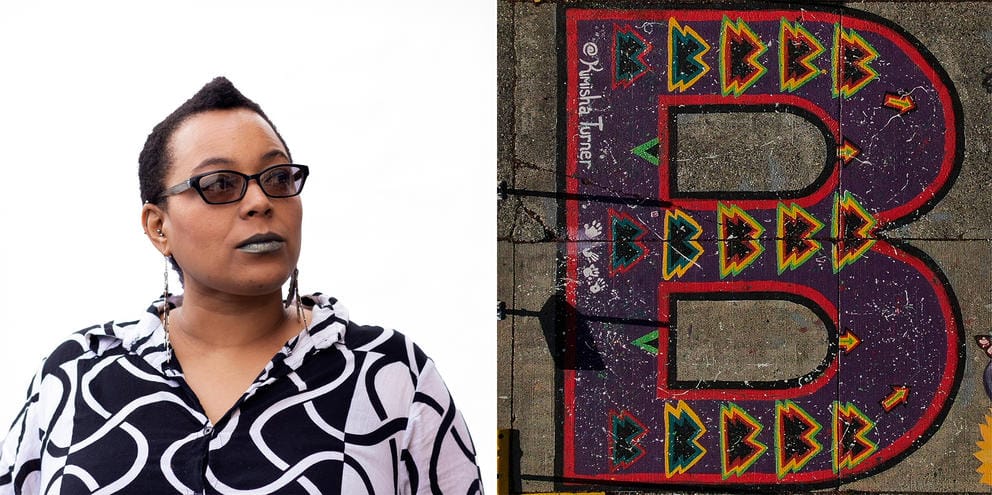
“I have always said that art literally saves lives,” says Kimisha Turner. “This last year with everything going on just underlined that. We saw so much art being made that helped us all cope with everything going on, as well as art that made people think differently about their role in the world and how we all have the responsibility to shape it.” (Left: Matt M. McKnight/Crosscut, Right: David Ryder for Crosscut)
Printmaking, photography, mosaic, woodcarving, performance, painting: In her nearly two decades long career as an artist, Kimisha Turner had worked in almost every medium under the sun. But until that day in June, she had never painted on concrete. With her son Malcolm, Turner filled the first letter, a purple “B,” with yellow, green and red arrows nudging the viewer’s eyes forward. “Being able to paint the “B” was an honor, as I was able to initiate this incredible statement with boldness, beauty, heritage and symbolism,” Turner says. “The arrows represent moving forward, while the colors speak to Black pride and our cultural influence that gets appropriated and/or taken for granted.”
What made it even more special: “the ability to create it with my son, a beautiful Black boy, and have that moment to share with him,” Turner says. “He will know that we created this image and painted this statement with him in mind. This will stay with me forever.”
What’s next: A mural for the Bethany Presbyterian Church in Queen Anne, as well as designing a temporary minigolf course for the Seattle Art Museum’s yearly fundraiser, plus ongoing work on her sugar-crystal sculpture series “Carbon Copy,” which symbolizes ancestral lineage and regeneration.
L: Perry Porter
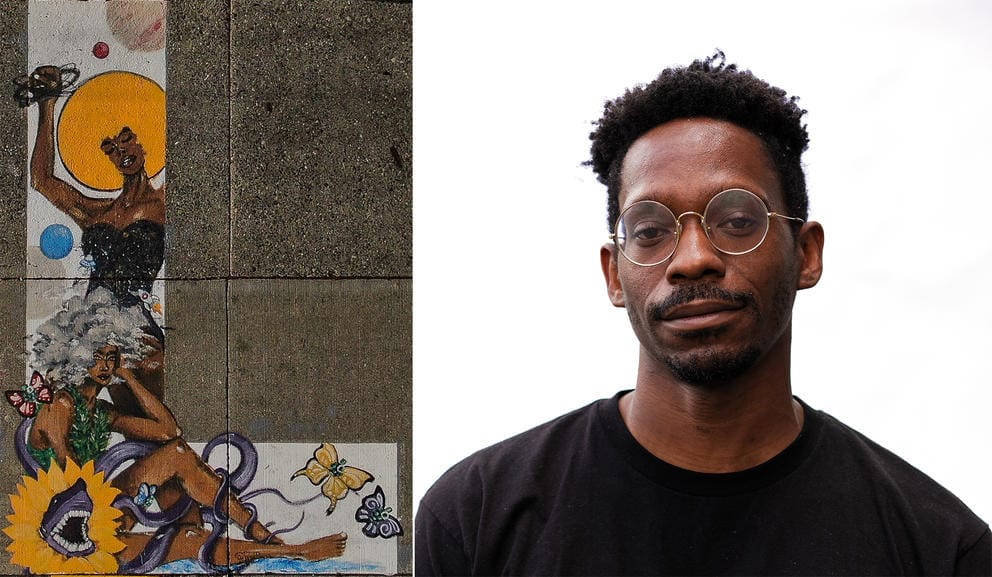
The protests consolidated Perry Porter’s belief that art can change lives: “Because of the attention around the mural I’ve been able to make a living off my art,” he says. “My community has poured so much love into me making sure I can take this art as far as I can.” (Left: David Ryder for Crosscut, Right: Matt M. McKnight/Crosscut)
A woman with a purple afro, flowers in hand, reclines into the lower corner of a huge L, as though she’s using the letter as a seat. Purple tentacles snake out from the letter’s rigid edges as butterflies flutter across the horizontal bar. The design is quintessentially Perry Porter, the Tacoma painter and songwriter who specializes in watercolor paintings and slightly surreal murals featuring people (mostly women) of color.
What does his design say to him today? “That Black magic is real and every L [loss] is a lesson to your legacy,” Porter says. Art, he likes to say, is power. That’s why he chooses to depict people of color in his paintings: to add these portraits to the still-too-white pantheon of visual culture.
For Porter, the Pine Street mural was a springboard to a full-time art career. The painting experience, combined with the protests, also strengthened his artistic resolve: “It validated what I was already doing,” he says. “Good affirmation to continue the good fight.”
What’s next: More music. “Because of the pandemic and protesting I laid low on the music tip,” Porter says. He plans to release his album Black Boy Joy this year.
A: Angelina Villalobos
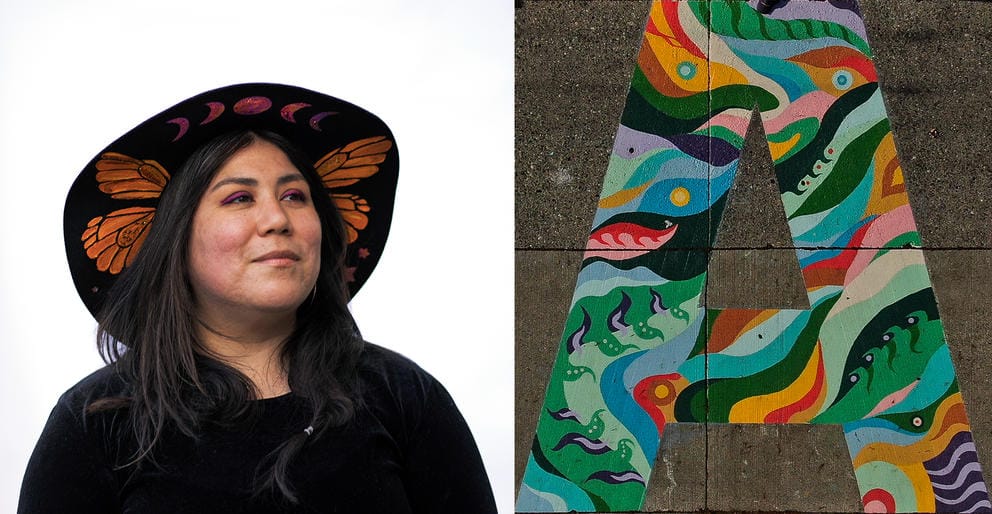
“Taking on the responsibility of the letter A is my testament that I will always work to educate myself, to listen with the intent and purpose and to hold myself accountable when I make mistakes, specifically when it comes to power and privilege,” says artist Angelina Villalobos. “One of my main principles as a public artist is to lead by example, and I am dedicated to that practice.” (Left: Matt M. McKnight/Crosscut, Right: David Ryder for Crosscut)
“I chose the letter A because it’s the first letter in the alphabet, but it’s also the first letter in my name. As a white-passing person of color, if I want to initiate change, I have to start with myself,” says Seattle artist and educator Angelina Villalobos about her “A,” which she infused with rippling strata of green and yellow vines and organic matter.
A year later, what has stuck with Villalobos most is the solidarity between the members of the collective. “We’ve built foundations to support each other,” she says. With Barry Johnson, she serves on the board of local street art nonprofit Urban Artworks, which has in turn partnered with Vivid Matter members Moses Sun, Perri Rhoden, AFROSPK and Perry Porter. “After years of being an artist on my own I have come into a family of creative minds, all with the same goal,” Villalobos says. “It truly is a testament to what community can build.”
What’s next: After recently completing murals for Facebook and the Seattle Seahawks, Villalobos is traveling to South Dakota for The Cheyenne River Youth Project's annual graffiti jam and also plans to take some time to reflect and build her art practice.
C: Perri Rhoden

“I wanted to break the letter C into compartments filled with color, and then I finished with black curvy lines over the blocks of color,” says Perri Rhoden. “The color palette, for me, celebrates the diversity of the Black diaspora.” (Left: David Ryder for Crosscut, Right: Matt M. McKnight/Crosscut)
This past year was filled with emotions — to say the least. “I felt furious, invisible and cautiously optimistic,” says Seattle mixed-media artist and muralist Perri Rhoden, when asked to summarize 2020. “This year I feel every emotion,” she adds. “A lot of good has happened in my life within the last year, and yet so much despair has transpired around the world. My optimism remains the same — cautious. But most of all, I do not feel safe. And I worry about the safety of my friends and loved ones every day.”
Rhoden just finished a mural for Eddie Bauer on 28th Avenue and Union Street with fellow Vivid Matter Collective member AFROSPK, as well as a set design for Atopic, a new film by local actor-filmmaker Lauren Du Pree. Rhoden opted to fill the “C” with a Lifesaver candy design. “I enjoy creating art when I need to escape from reality or when I need a therapeutic release,” she notes.
What’s next: Rhoden will be installing a mural at Midtown Square, the new Central District development at 23rd Avenue and Union Street, later this summer.
K: ARI Glass
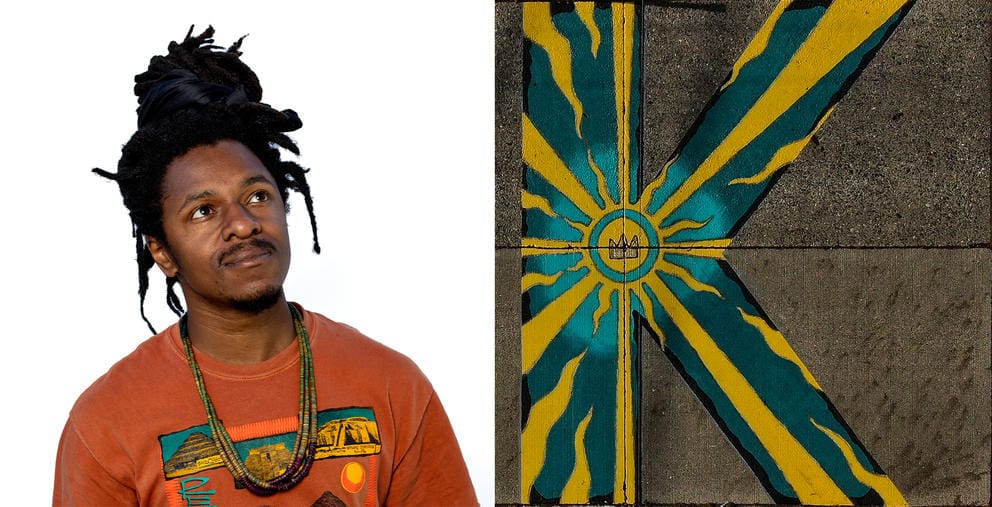
“These issues are nothing new in America,” says ARI Glass. “When CHOP/CHAZ originally started it was kinda fire ... like a village where everything was free and built on integrity to spread a powerful message,” Glass adds. “It will be interesting to see what its legacy will be.” (Left: Matt M. McKnight/Crosscut, Right: David Ryder for Crosscut)
ARI Glass paints with gold, literally. The multidisciplinary artist often uses gold leaf to make his intricate paintings shimmer with divine and regal overtones. He’s also fascinated by the kings and queens of (art) history, and the sun itself. One of his first art shows, in 2015, was titled “The Sun is Made of Gold.” (Worth noting: many peoples of the Andean region saw gold as the sweat of the sun, the most sacred deity.)
These fascinations came together on East Pine Street in his letter “K.” This time, Glass did not use actual gold leaf, but a golden-hued sun does shine at the heart of the letter. “My letter is ‘K,’ one of my favorite letters,” Glass says. “It represents the ‘King’ or royal aspect that Black people embody, our kings and queens. My design is the shining sun, we know how we shine ... how the melanin gleams.... Surrounding the sun is an ocean of blues, our sacred water element. The sun and water, essential to creation and essential for the original people.”
What’s next: Coming off a showing of his work in the group exhibit Yellow No. 5 at the Bellevue Arts Museum, Glass is “cooking up new studio work for something epic, a few fresh public works this summer, new Paradice Avenue Souf designs and developing new magic with the VMC gang.”
L: Cody Kalani
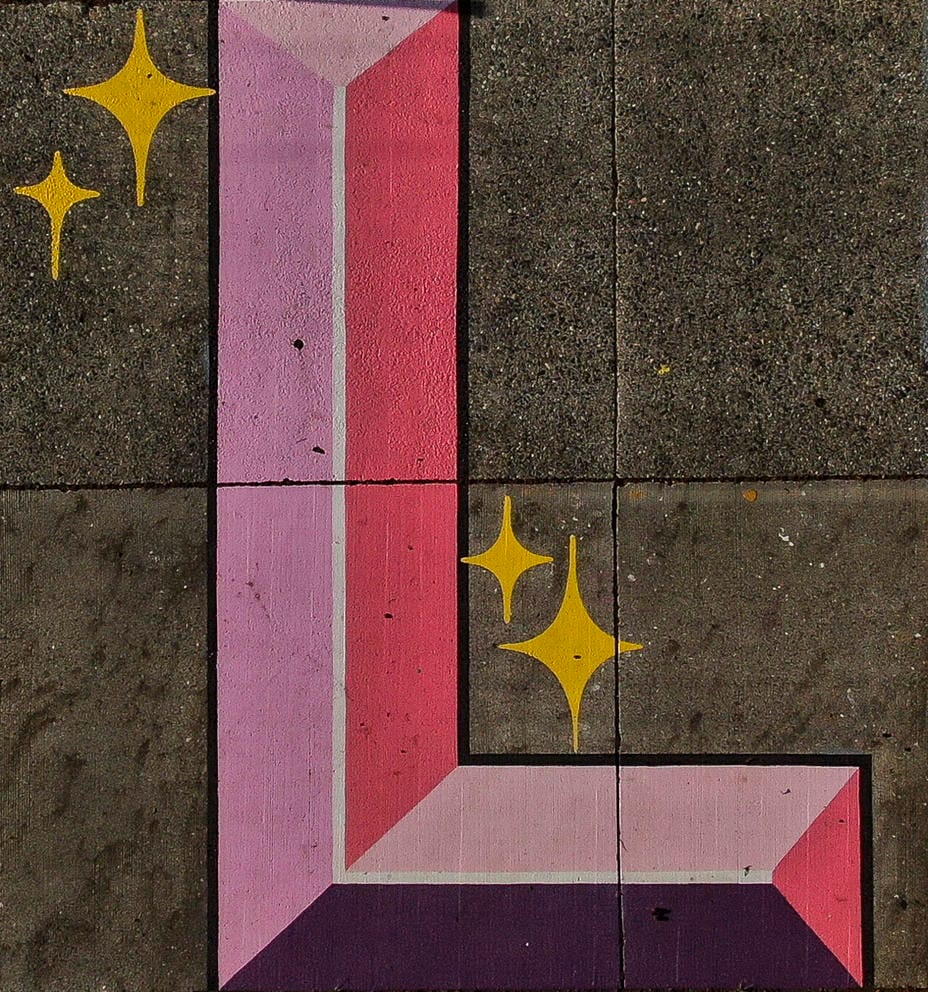
Cody Kalani painted the “L” in the Black Lives Matter mural with a 3D design in vivid pink that appears to glimmer with gold sparkles. We were unable to reach Kalani for a photo or interview. (David Ryder for Crosscut)
I: Teddy “Stat” Phillips and Vivid Matter Collective

The Vivid Matter Collective repainted the "I" together after a repair snafu this past September. They divided the letter into 16 sections, one for each collective artist. (David Ryder for Crosscut)
Though artist/entrepreneur Teddy “Stat” Phillips is no longer with the Vivid Matter Collective, the mural painting experience — and last year at large — came with lasting realizations: “I realized that you can leverage art to advocate activism,” he says.
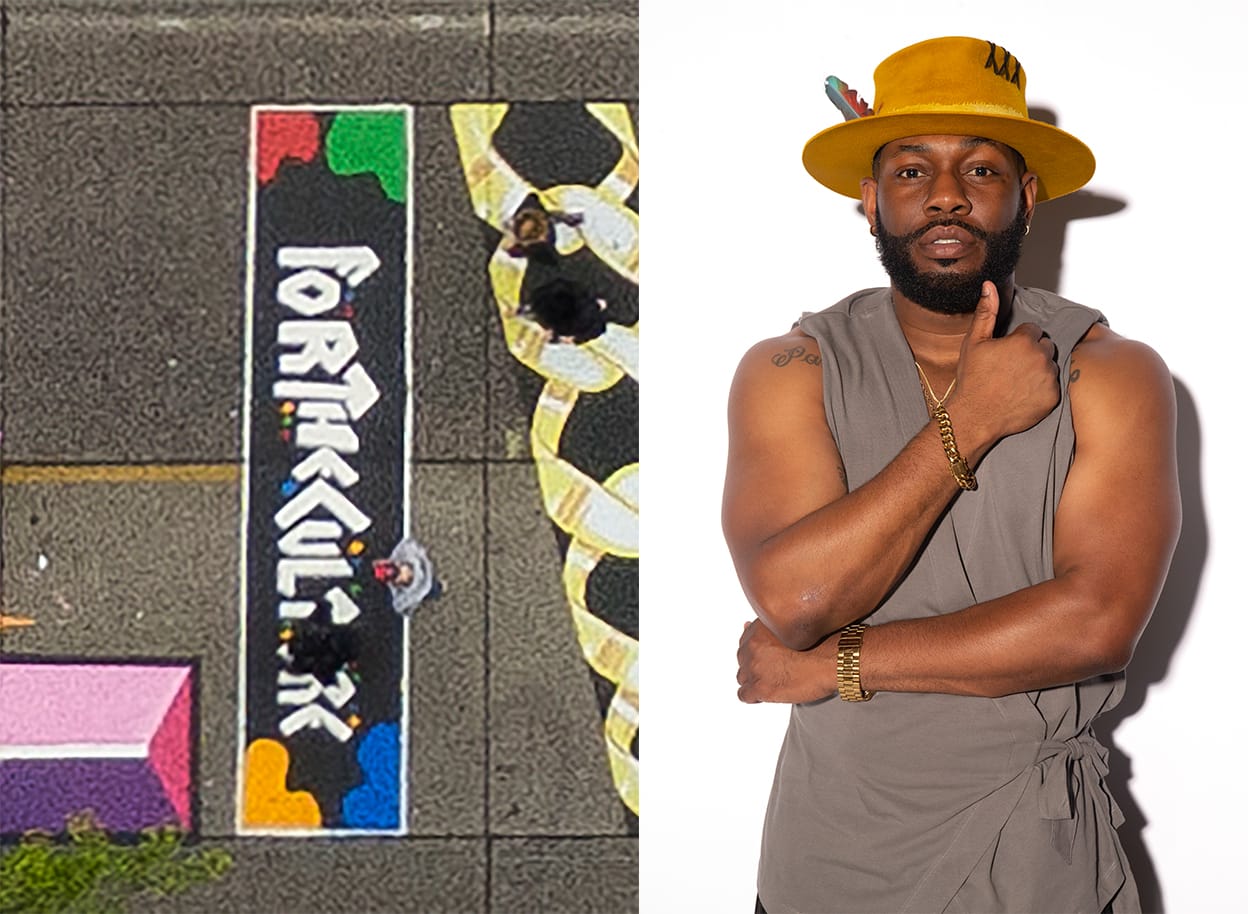
Phillips wrote “For the Culture” in his letter, a mantra he lives by: “It means honoring your ancestors and the sacrifices that they made to allow you to be in a better position today and keeping your community at the forefront at all times,” he says.
This past September, after a repair snafu, the Vivid Matter Collective repainted the mural so it would last longer. Many artists updated and optimized their individual designs and the group repainted the “I” together. “Brandon ‘ArtbreakerBT’ Thomas came up with the design,” says Takiyah Ward. “If you look closely, you can see the “I” was intentionally dissected into 16 sections,” she says, “and those parts together loosely resemble the letters VMC. Each artist then added their own personal touch to a section. We wanted to show that while there’s no ‘I in team,’ there is a team in this “I” and in this mural.”
V: Aramis O. Hamer

“What has stuck with me is the incredible friendships that were formed from the mural,” Aramis O. Hamer says. “It was my first time meeting a few of the artists the night we painted together. Now, we are closer and stronger as Vivid Matter Collective. I’m so grateful that Takiyah brought us all together.” (Left: David Ryder for Crosscut, Right: Matt M. McKnight/Crosscut)
Seattle artist Aramis O. Hamer is known for her otherworldly tableaux of cosmic goddesses in surreal, hyper-saturated landscapes — as if she has dipped her brushes in LSD. By painting, Hamer says, she creates the world she wants to see.
Art has that kind of power. And that’s especially true for the past year. “All art forms have helped and continue to help us get through this collective dark night of the soul,” Hamer says. “Years in the future, I think we will speak of 2020 as being a Birth of a Renaissance.”
Today, the golden chains featured in her “V” design provide two reminders: “One: liberate myself and, two: live my life in a way that might inspire liberation in others,” she says.
“I’m honored to have been a part of a historic mural, but it is also a visual reminder of all the Black lives that have been lost,” Hamer adds. “Overall, don’t memorialize the monument and miss the message.”
What’s next: Hamer just wrapped up a series of zodiac paintings, which will be reproduced as a series of limited edition altar candles. Reproductions of Hamer’s “jeweled goddess” painting are currently on display in more than 30 Ben Bridge Jeweler locations along the West Coast. She’ll be selling the painting as a print to raise awareness and funds for the nonprofit Black in Jewelry Coalition.
E: Barry Johnson
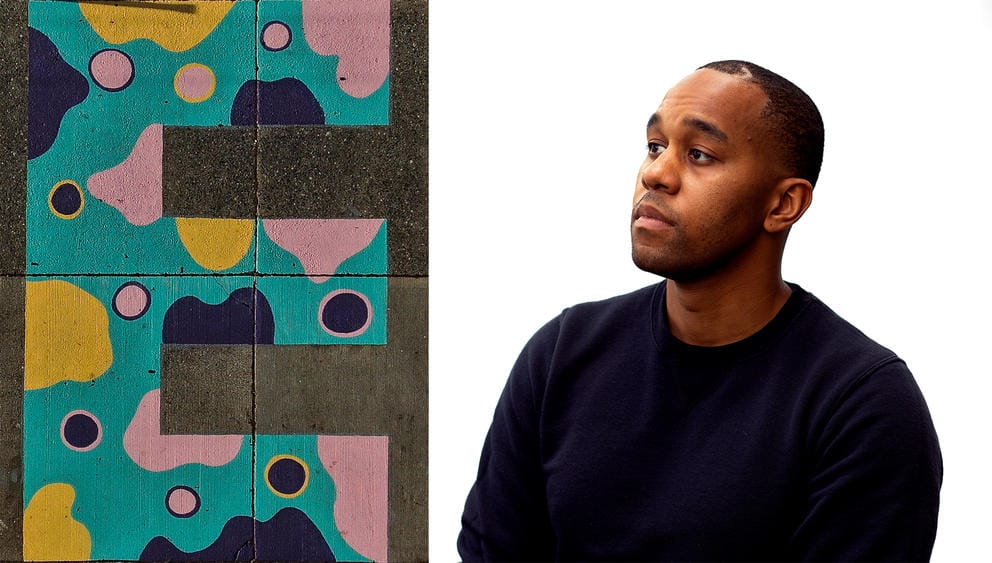
“It was great to see the city come together,” Barry Johnson recalls. “I remember right around this time last year getting calls from people that I barely spoke with, checking in, sharing moments and being open to listen. I seriously thought people were fucking with me at first. It had never happened in my life, so I was really taken aback and very guarded. As it kept happening, I realized people were being genuine and I grew to appreciate this place more.” (Left: David Ryder for Crosscut, Right: Matt M. McKnight/Crosscut)
“When given the choice to pick a letter, I picked “E” for my daughter Eva,” says multidisciplinary Seattle artist Barry Johnson. “She changes her favorite color often, but at that time it was teal and pink.” Also included in the design: Love. That, he says, is the message of the letter, then and today. “It’s the thing we need most,” he says. “I fought everything that we’re up against with love.”
And with art: “I’ve always thought art has immeasurable powers,” he says. “During the protest, cities around the world turned into large sketch journals for almost anyone to share how they felt, and, surprisingly, it was almost the same,” he says. “Versions of the same images, names and faces were shared everywhere. I hope those that did not understand the power of art understand now.”
What’s next: A large mural by Johnson is currently going up on the side of a new building development on 23rd and Union. But when asked what’s next, he says: “I’m just going to continue doing everything it takes to show you all how dope I am. That’s all.”
S: Sam Sneke

Sam Sneke says something that has stuck with him since the protests last year is “the community as a whole coming together for greater causes.” (Left: Matt M. McKnight/Crosscut, Right: David Ryder for Crosscut)
A string of red graffiti snakes around the bends of the “S.” The letter’s square footage can barely contain the words, as if the statement is ready to burst out: “Can’t Truss It!” Longtime local graffiti artist Sam Sneke sampled the words from a 1991 Public Enemy song by the same name, “stemming from a long list of police not being able to protect and serve communities where they do not reside,” he says.
Originally, he had filled the letter with the words, “Who protects us from you?” from the eponymous song by Boogie Down Productions, about police abuse of power. During the mural’s repainting last year, he chose the Public Enemy lyric instead. Now, in a way, the letter is imbued with both messages.
“The protests made me think of a higher calling for what I do,” Sneke says, “the power it has to reach more people with a message.”
What’s next: “I’m really just trying to open myself up again. There are art opportunities everywhere. I just need some time to organize where I wanna place my works.”
M: Moses Sun
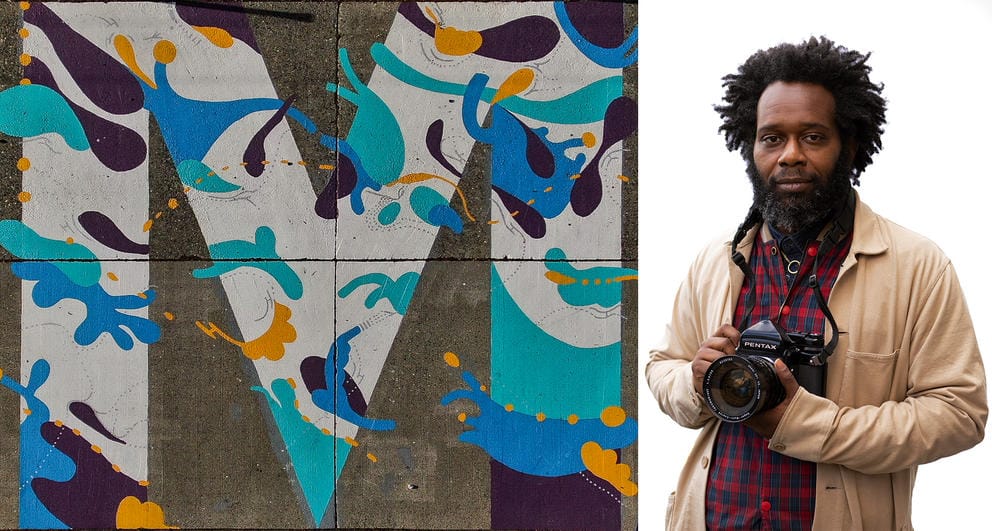
One year after the protests, Moses Sun says what resonates is that “anything is possible if you align your heart with intention.” (Left: David Ryder for Crosscut, Right: Matt M. McKnight/Crosscut)
M is for Matters. M is for message (as in: don’t forget the message). But the multitalented (another “m”) Moses Sun also chose to paint the “M” in honor of his father, named Moses as well. He was an activist, just as Sun’s grandfather was.
The design of the letter — flowing droplets of purple, blue and orange — “says to break barriers through listening and collaborating with intention,” Sun says. Here, as in many of his recent murals (for Facebook, Starbucks and on the Columbia City Theater), rigid edges and borders melt away into lyrical abstraction and organic shapes that seem to be ever-expanding, intersecting and growing.
“The message of the mural sparked many opportunities for me to grow artistically and spiritually,” Sun says today. “The pandemic and protests reawakened my sense that art is a mirror of a kaleidoscope of human experiences. Conversation with the community can lead to change — by creating art that reflects the culture of the diasporas [from which] they originate.”
What’s next: Sun is currently working on a series of limited edition art boxes containing a zine and various art pieces (launching June 19). Other collaborations, he says, are in the works.
A: Brandon Thomas
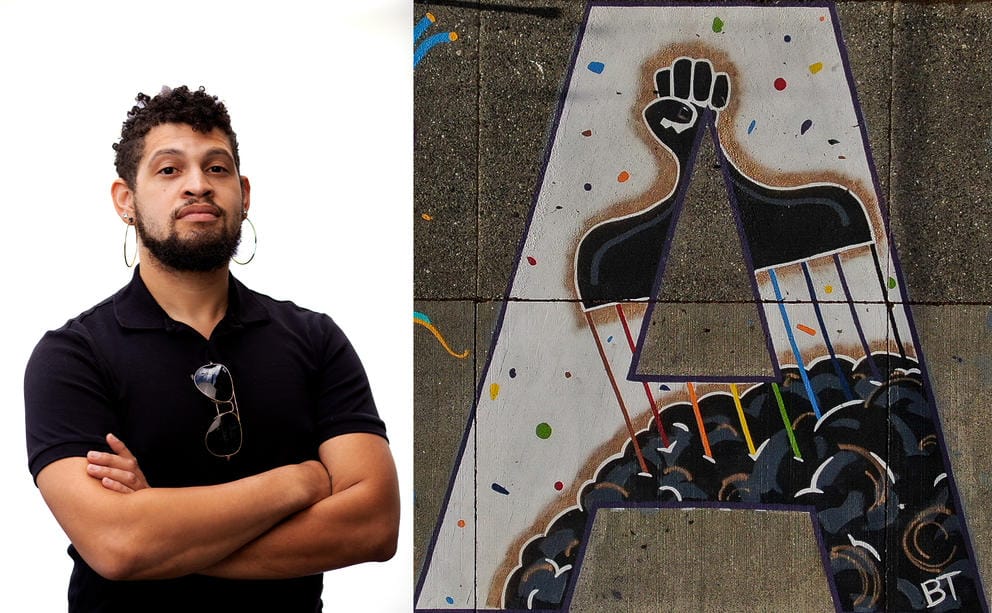
“The Vivid Matter Collective is the family I have been yearning for in excess of 25 years,” says Brandon Thomas. “I cry tears of joy almost every time I see them.” (Left: Matt M. McKnight/Crosscut, Right: David Ryder for Crosscut)
“When COVID hit, I lost a handful of gigs and was really feeling unsure about the place art has while the world is burning,” pop-surrealist artist Brandon Thomas (aka ArtbreakerBT) remembers. Thomas found a new hope when they became part of the Vivid Matter Collective. “Artists help envision a better world while we transport people into fantasies of our design,” Thomas says.
Thomas, who says their style is influenced by Kehinde Wiley, Salvador Dalí and South Park, opted for an Afro and pick. “As someone more light-skinned, my hair has still definitely been an immediate source of attention for micro- and macroaggressions,” Thomas says. “Being on the constant lookout for having your personal space invaded is as essential to the Black experience as the pride we have in our magical curls, locks, weaves, fades, fros, rows, you name it.”
Speaking of pride: Notice the subtle rainbow in the teeth of the comb? As Thomas puts it: “I wanted to intersect my queerness as well, especially given that we were in Capitol Hill…. Black Lives have and will always include the queerdos.”
What's next: Since the mural, Thomas’ calendar has been full of projects, including the publication of a book they illustrated. Thomas will also be the face of the Seattle Summer Reading program, has multiple murals on the horizon and has co-created Blaque Mass Studios, a community art studio that aims to reclaim space through Black creation and joy, opening Juneteenth.
TT: Takiyah Ward
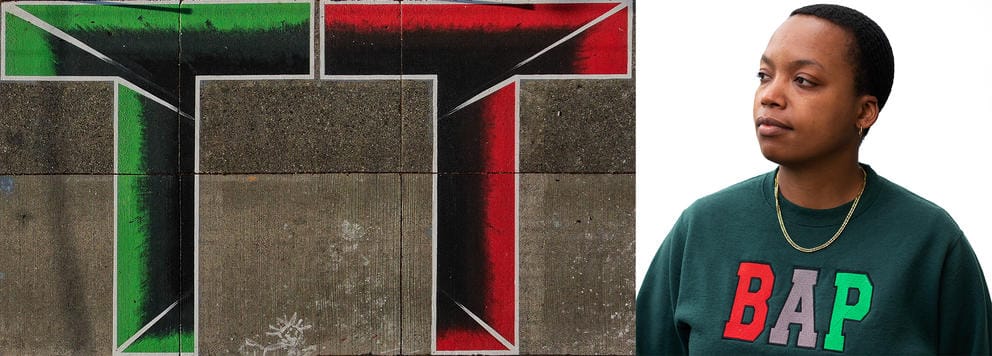
“What stuck with me from last year’s protests is the fact that people demanding justice were met by the strong arm of law enforcement in such a brutal way,” says Takiyah Ward, one of the two initiators of the mural. “It’s difficult for me to interpret it as anything other than trying to keep us in our ‘place,’ that our demands didn’t matter as much as the status quo.” (Left: David Ryder for Crosscut, Right: Matt M. McKnight/Crosscut)
Since high school, local artist Takiyah Ward (aka T-DUB Customs) has been painting and airbrushing clothing and sneakers to create one-of-a-kind pieces. She went on to study architecture. Those influences merge in her trompe l’oeil double “T,” which appears to plunge into the abyss below the pavement. “My idea behind the design was to create a visual for how deep this conversation around Black Lives Matter goes,” Ward says. “How ingrained it is into the very core, soil, concrete, infrastructure of this city, state and country. I think the events that have transpired in this country since last year only prove just how true and necessary the amplification of this message is.”
Particularly during a pandemic. “It baffled me that after all we had been through as humans at the beginning of last year with COVID, we were once again having to protest the loss of Black life at the hands of police,” Ward says. “How do you have the energy to exact such brutality in the midst of a pandemic?”
What’s next: Ward is currently working on a mural for the Midtown Project on 23rd and Union that will represent a visual history of the Black Central District from the beginning to now.
E: Future Crystals

“The idea behind the crystals was about the ‘many’ represented in each stone and the differences between each one of them,” says artist Future Crystals. “When you step back, though, you get perspective and realize that it all just looks the same…. We are more similar than different.” (Left: David Ryder for Crosscut, Right: Matt M. McKnight/Crosscut)
Around this time last year, multimedia artist Future Crystals had their mind set on being an artist, fashion designer, filmmaker and freelance video editor. “But when I started livestreaming last spring for BLM and saw the impact of what I was doing, something changed,” Future Crystals says. They filled the letter “E” with shining, multifaceted gems. “I found my purpose, experienced community accountability and opened up to a dramatic self-realization and basically a breakdown of who I was and what I was doing before May 25th. Creating art for the mural was part of this shift for me in learning to be part of a collective.”
It has also changed the way they think about art: “The pandemic and political divisions made it possible for the lies and injustices to be seen clearly, and for more solidarity to happen across communities,” they say. “Art got us this far and it is always going to be a factor forever in moving social justice.”
What’s next: Future Crystals has recently been spending time in Minneapolis, painting murals, meeting local organizers and participating in the one-year memorial marking the murder of George Floyd.
R: AFROSPK

AFROSPK painted the “R” in the Black Lives Matter mural with a “Tasty Cloud” motif, featuring multicolored blobs with open mouths. AFROSPK declined our request for a photo and interview. (David Ryder for Crosscut)



